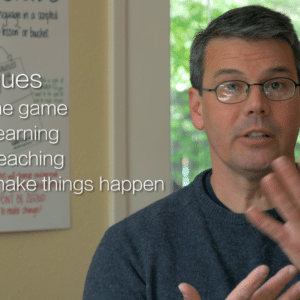
As in language-learning, studying math involves plenty of rigorous proofs–you take what knowledge you know, and then you use it to find new knowledge. Luckily, language acquisition doesn’t have to be as complicated as this blackboard. (Credit: Clay Shonkwiler, Flickr, Creative Commons)
This post is fifth in a series of entries about WAYK techniques as they occur in everyday life, beyond language-learning.
How do you show someone you’ve learned something? Naturally, you repeat that knowledge to that person rather than simply stating “Yes, I’ve learned it.” You impress that person even more when you apply your newly-acquired knowledge in new, unforeseen situations; rather than simply blindly following instructions in preset environments–which are very convenient, but very rare in life–you show that your brain is flexible and that you’re truly aware of what you’re doing. The WAYK technique “Prove It” takes this element of daily life and applies it to language-learning. You use a bit of language–a word, a phrase, a sentence structure–that you recently learned in a set-up beyond the one in which you learned it. When you “Prove It”, you learn in what situations a piece of language fits and doesn’t fit, and you fix that piece of language more securely in your brain.
Proving your skills is more essential than at first glance. You may receive a diploma from high school or college and claim to have a set of knowledge and skills, but when you are hired, you must show that you, in fact, do possess a given amount of know-how in order to keep your job. You probably wouldn’t want your employers to think you’re a hack, that you got your diploma by achieving the bare minimum for it. If you’ve seen the infamous TV game show Are You Smarter than a 5th-Grader?, you’ve noticed a harsh truth about how grown-ups claim to have learned basic knowledge. Unfortunately for many of the adult contestants–and hilariously for us watching at home–they can’t prove they learned things in elementary school even though they clearly graduated from it. (Maybe they’ve forgotten simple math, science, and grammar, but it’s still basic knowledge.) The ultimate embarrassment is when contestants fail questions that kids answer correctly: the adults must then admit to the world, “I am not smarter than a 5th-grader.”
Life is full of opportunities to “Prove It”. Once, when I was driving a rental car, taking several of my dormmates from our campus to San Francisco, one of my dormmates asked me if I was a safe driver. Of course, I couldn’t rent a car without my license, but of course, that wasn’t enough proof. Many licensed drivers drive unsafely, moving too close to cars and not having both hands on the wheel at all times. I could only show my passengers I was being careful during the trip to SF. At the same time, I was paying attention to my driving as well, so I had to make sure I was, in fact, maneuvering with extra care. The experience helped me improve my future driving as well.
In school, the ways to “Prove It” are obvious: you finish homework, pass tests, and give knowledgeable presentations. They’re usually given with set deadlines. Typically, you can receive outside help on homework, with others “pulling you through it” if you’re having trouble. On the other hand, you’re on your own on tests and presentations.
WAYK is different: you’re tested constantly, but you’re tested only when you think you’re ready, not at pre-determined times. Most of the time in WAYK, your “angels on your shoulder” are “pulling you through it”. However, you’re only tested individually when you need to “Prove It”, whether you want to use just one new word or whether you’re being tested on your fluency on the ACTFL scale; only then will you be on your own. You set your own pace for learning, which makes learning more comfortable and thus a lot more efficient.
I hope you can prove that you know how to “Prove It”! And when you play WAYK with your friends, I hope you prove your knowledge of WAYK techniques and how and when to bring them up “Just in Time”.




